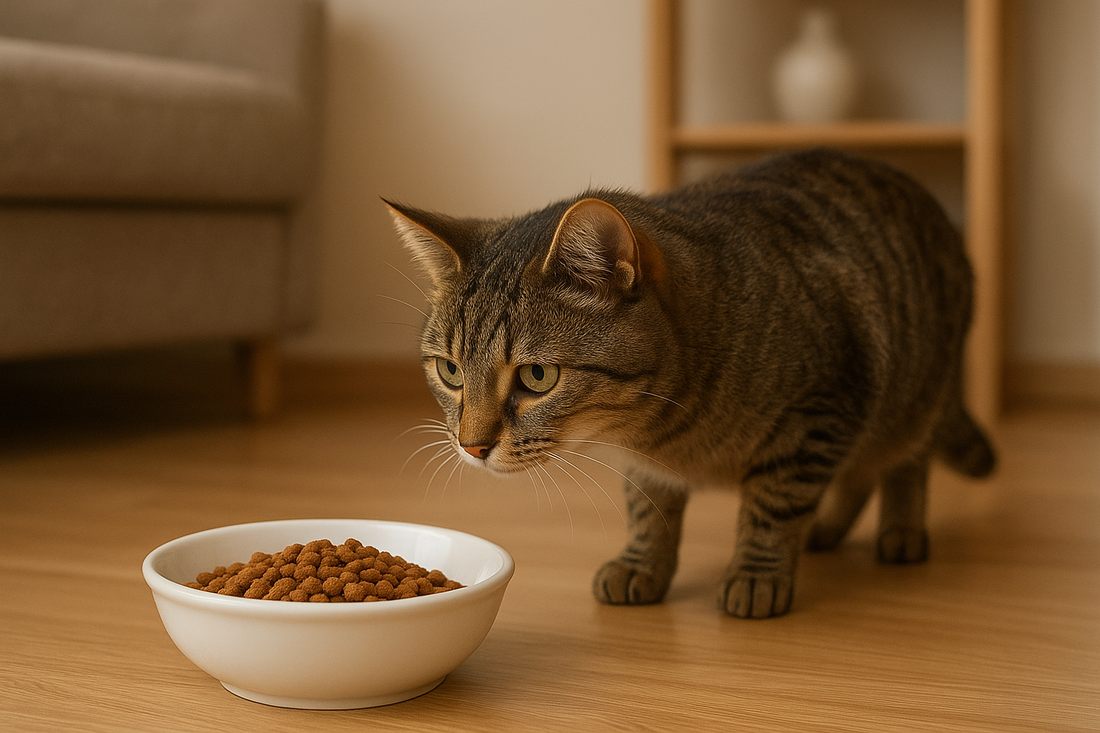
How to Transition Your Cat to a New Diet Safely
Changing your cat’s diet is one of the most important decisions you can make for their health. Whether you’re switching to a higher-quality food, accommodating a veterinary recommendation, or transitioning from wet to dry food (or vice versa), the process requires careful planning. Cats have delicate digestive systems, and abrupt dietary changes can lead to gastrointestinal upset, stress, or even long-term health issues.
In this guide, we’ll cover why a safe transition is crucial, how to recognize potential warning signs, step-by-step instructions for switching foods, and tips to make the process smoother for both you and your feline friend.
Why Diet Transitions Matter
Cats are creatures of habit, and their digestive systems are sensitive to changes. Unlike humans, they cannot easily tolerate sudden alterations in nutrient sources. Abrupt changes in diet can lead to:
- Diarrhea or loose stools: A sudden change in protein, fat, or fiber can disrupt gut bacteria balance.
- Vomiting: Cats may vomit if the new food irritates the stomach lining.
- Reduced appetite: Some cats are picky eaters and may refuse unfamiliar foods entirely.
- Stress: Cats thrive on routine, and new foods may introduce uncertainty, leading to anxiety-related behaviors like hiding or over-grooming.
A gradual introduction of a new diet minimizes these risks and ensures your cat continues to receive the necessary nutrients.
Pro Tip: Even if your cat has no apparent sensitivities, transitioning slowly is always safer. Cats’ digestive reactions can be subtle at first, and early signs of intolerance are easier to manage than sudden digestive emergencies.
Signs Your Cat May Need a Diet Change
 Before transitioning your cat’s food, consider why a change is necessary. Common reasons include:
Before transitioning your cat’s food, consider why a change is necessary. Common reasons include:
1. Weight management: Cats that are overweight or underweight may benefit from specialized diets tailored to their condition. Overweight cats can develop diabetes, arthritis, or heart problems, while underweight cats may be malnourished.
2. Allergies or sensitivities: Some cats develop reactions to certain proteins, grains, or additives. Signs include itchy skin, hair loss, ear infections, or gastrointestinal upset. Food allergies are less common than environmental allergies, but they can significantly impact your cat’s quality of life.
3. Medical conditions: Conditions such as kidney disease, diabetes, or urinary tract issues may require therapeutic diets prescribed by your veterinarian. Specific formulas can help manage these conditions and prevent complications.
4. Age-related needs: Kittens, adult cats, and senior cats have different nutritional requirements. Aging cats may benefit from diets designed to support joint health, kidney function, or dental care.
5. Improved nutrition: Switching to higher-quality food with better ingredients can enhance coat health, boost energy levels, and improve overall well-being.
Fun Fact: Cats are obligate carnivores, meaning they require meat-based proteins for essential nutrients like taurine. Low-quality foods may lack these nutrients, affecting long-term health.
Tips for Choosing the Right Food

Not all cat foods are created equal. When selecting a new diet, consider the following:
- Quality ingredients: Look for high-quality animal proteins (chicken, fish, turkey) as the primary ingredient. Avoid foods with excessive fillers, artificial colors, or by-products.
- Life stage suitability: Ensure the food is formulated for your cat’s age group. Kitten, adult, and senior cats have different nutritional needs.
- Health considerations: If your cat has medical conditions, consult your veterinarian before changing their diet.
- Preference testing: Cats can be finicky. Sometimes you may need to try a few brands or flavors to find one your cat enjoys.
- Nutritional balance: Check that the food meets AAFCO (Association of American Feed Control Officials) standards, ensuring it provides complete and balanced nutrition.
Preparing for the Transition+
 Before starting the diet change, prepare both yourself and your cat:
Before starting the diet change, prepare both yourself and your cat:
1. Create a calm feeding environment: Stress can reduce appetite and make your cat more resistant to new foods. Feed in a quiet area away from other pets.
2. Gather necessary tools: Have separate bowls for old and new food, a measuring cup for portion control, and paper towels for any potential mess.
3. Set aside a timeline: Plan for a 7–10 day gradual transition to avoid digestive upset. Longer transitions (2–3 weeks) may be necessary for particularly sensitive cats.
4. Track progress: Keep a notebook or app to record how much of the new food your cat eats, their stool consistency, and any behavioral changes. This helps identify issues early.
Step-by-Step Guide to Transitioning Your Cat’s Diet
 Here’s a tried-and-true method for safely introducing a new diet:
Here’s a tried-and-true method for safely introducing a new diet:
Step 1: Start Small
- Day 1–2: Mix 25% new food with 75% old food.
- Observe your cat’s appetite and stool consistency. Some mild digestive changes are normal, but severe vomiting or diarrhea warrants pausing the transition.
Tip: Use a separate bowl for the new food so your cat has the option to explore it at their own pace.
Step 2: Increase Gradually
- Day 3–4: Adjust to 50% new food and 50% old food.
- Continue monitoring for any signs of distress. Maintain fresh water availability to prevent dehydration.
Step 3: Majority New Food
- Day 5–6: Move to 75% new food and 25% old food.
- At this stage, your cat should start accepting the new flavor and texture more readily.
Step 4: Full Transition
- Day 7–10: Offer 100% new food.
- Ensure your cat continues to eat regularly and maintains normal bowel movements.
Tip: If your cat refuses the new food at any stage, slow the transition by holding at the current ratio for a few more days. Patience is key.
Troubleshooting Common Issues
 Even with careful planning, some cats may experience minor challenges during the transition. Here’s how to address them:
Even with careful planning, some cats may experience minor challenges during the transition. Here’s how to address them:
Loss of Appetite
- Sprinkle a small amount of tuna juice or chicken broth (without onion/garlic) to entice eating.
- Warm the food slightly to enhance aroma and palatability.
- Serve smaller, more frequent meals instead of one large portion.
Vomiting or Diarrhea
- Reduce the new food ratio and extend the transition period.
- Ensure fresh water is available to prevent dehydration.
- Consult your veterinarian if symptoms persist beyond a few days.
Food Refusal
- Try mixing textures (wet and dry) to make the food more appealing.
- Experiment with different flavors of the same brand.
- Offer the new food during separate meals rather than combining with old food.
Pro Tip: Some cats prefer food served at room temperature, so let refrigerated food sit for 10–15 minutes before feeding.
Special Considerations
 Cats with Sensitive Stomachs
Cats with Sensitive Stomachs
Cats with gastrointestinal issues may require an even slower transition or a specialized diet. Your veterinarian may recommend a bland diet (such as boiled chicken and rice) for a short period before gradually introducing the new commercial food.
Multi-Cat Households
Transitioning multiple cats simultaneously can be challenging. Feed each cat in a separate area to ensure everyone receives the correct portion and the new diet. Monitor interactions to prevent food guarding or stress.
Wet vs. Dry Food Transition
If switching between wet and dry food:
- Mix small amounts of dry food into wet food or vice versa.
- Monitor hydration, as wet food provides additional water content, while dry food may require more water intake.
Many veterinarians suggest combining wet and dry food to give your cat a well-rounded diet. Not sure which option fits your feline best? Check out our guide on Wet vs. Dry Cat Food for the full breakdown of benefits, drawbacks, and feeding advice.
Treats and Snacks
Avoid giving excessive treats during the transition. Treats can reduce appetite for new food and create confusion about preferred flavors. Stick to one small, consistent treat type to minimize conflicts.
Monitoring Your Cat’s Health During Transition
 It’s essential to observe your cat throughout the diet change. Key indicators include:
It’s essential to observe your cat throughout the diet change. Key indicators include:
- Stool consistency: Firm, well-formed stools indicate digestive tolerance.
- Energy levels: Persistent lethargy may indicate intolerance or nutritional imbalance.
- Coat condition: Dull fur or increased shedding could suggest dietary issues.
- Behavioral changes: Reduced grooming, hiding, or irritability may signal stress or discomfort.
Extra Tip: Keep track of your cat’s water intake. Cats are notorious for low water consumption, especially when eating dry food. Proper hydration is vital during dietary changes.
Tips for a Smooth Transition

- Consistency is key: Stick to a regular feeding schedule to maintain routine.
- Avoid frequent brand changes: Frequent switches can destabilize digestion.
- Reward positive behavior: Praise your cat when they try or accept new food to create positive associations.
- Consult a veterinarian: Always reach out for guidance if your cat has health conditions or shows adverse reactions.
- Patience matters: Cats may need multiple attempts before fully accepting a new food.
Why Gradual Transitions Improve Long-Term Health
A careful, gradual diet change supports long-term health in several ways:
1. Stable gut microbiome: Gradual changes allow beneficial gut bacteria to adapt.
2. Reduced stress: Cats are sensitive to sudden changes in routine, including diet. A slow transition helps minimize anxiety.
3. Better nutrient absorption: Proper adjustment ensures your cat receives all essential nutrients.
4. Fewer health complications: Sudden diet changes can exacerbate existing conditions like diabetes or kidney disease.
Alternatives and Supplements
Sometimes, a gradual transition can be enhanced with supplements:
- Probiotics: Support healthy digestion during dietary changes.
- Digestive enzymes: Help cats tolerate new proteins or fibers.
- Toppers and mixers: Add a small amount of flavoring to entice eating.
Always consult a veterinarian before adding supplements to your cat’s diet.
Final Thoughts
Transitioning your cat to a new diet doesn’t have to be stressful or risky. With careful planning, patience, and attention to your cat’s cues, you can successfully introduce a healthier or more suitable food that supports your feline companion’s wellbeing.
Remember, cats thrive on routine and predictability, so a slow, gradual approach is always best. By following these steps, monitoring health indicators, and being flexible based on your cat’s needs, you’ll create a smooth dietary transition that contributes to a long, happy, and healthy life for your furry friend.

Quick Recap for a Safe Diet Transition:
1. Assess why the change is necessary.
2. Choose a high-quality, appropriate food.
3. Prepare a calm feeding environment.
4. Gradually mix old and new foods over 7–10 days.
5. Monitor appetite, stool, and behavior.
6. Adjust the pace if your cat shows signs of distress.
7. Consult your veterinarian for sensitive or special needs cats.
Transitioning your cat’s diet safely may require time and patience, but the benefits—improved digestion, better health, and happier mealtimes—are well worth the effort. By following a structured approach, you ensure your cat continues to thrive, one meal at a time.
Tags: Transition cat to new food, Cat diet change, How to switch cat food, Cat food transition tips, New cat food guide, Safe cat diet change, Cat nutrition tips, Cat Care, Cat Nutrition, Cat Health, Pet Tips, Feline Diet, Cat Feeding, Pet Nutrition
